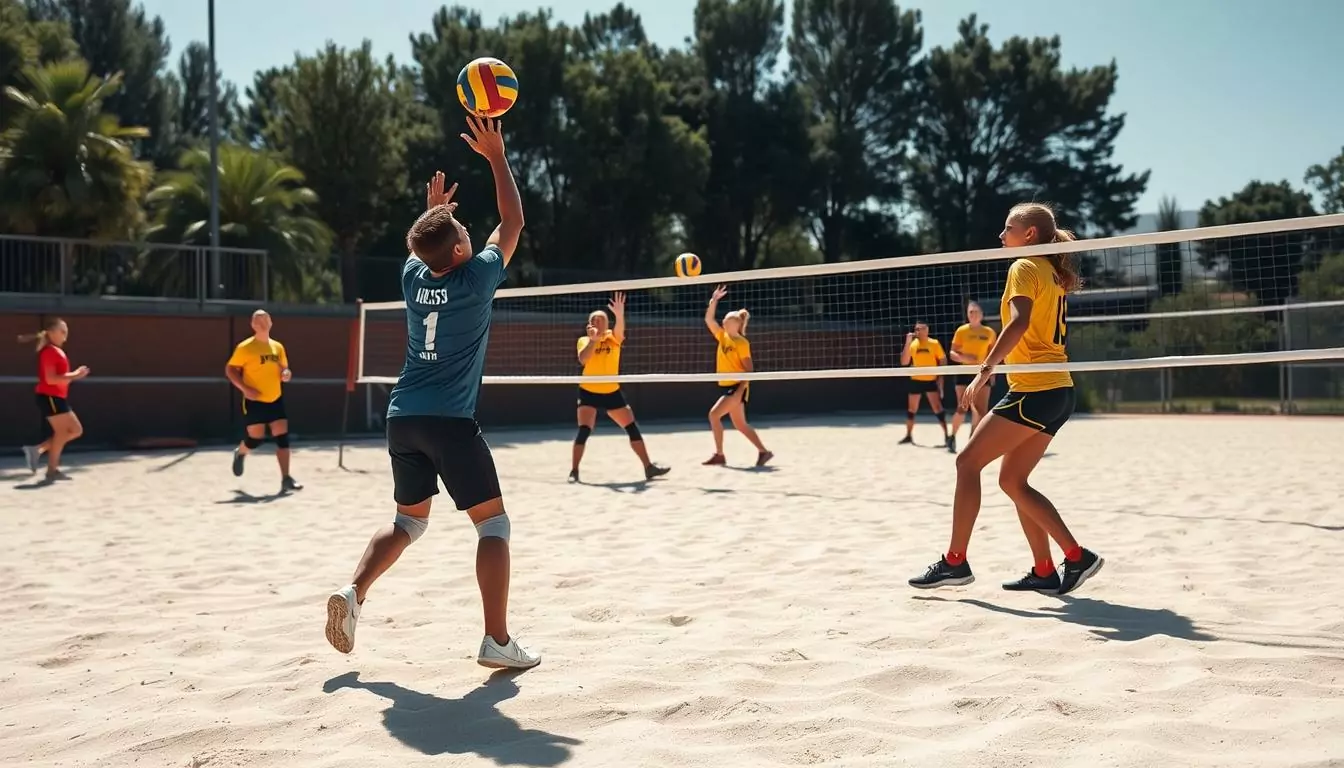I was once a high school varsity volleyball player. I learned how key a strong serving technique is. Serving can change the game’s flow and momentum. When I served, I felt a rush of adrenaline, knowing it could win or lose a point.
That’s why I’m excited to share top volleyball serving drills and tips. These helped me and my teammates excel on the court.
Key Takeaways
- Serving errors often come from bad tosses, showing the need for a consistent toss technique
- Boosting arm and hand speed is vital for more powerful serves
- Fixing mechanical issues in the arm swing can greatly improve serving
- Drills can help players overcome mental blocks and serve faster
- Keeping serving techniques simple can reduce errors and boost proficiency
Importance of Serving in Volleyball
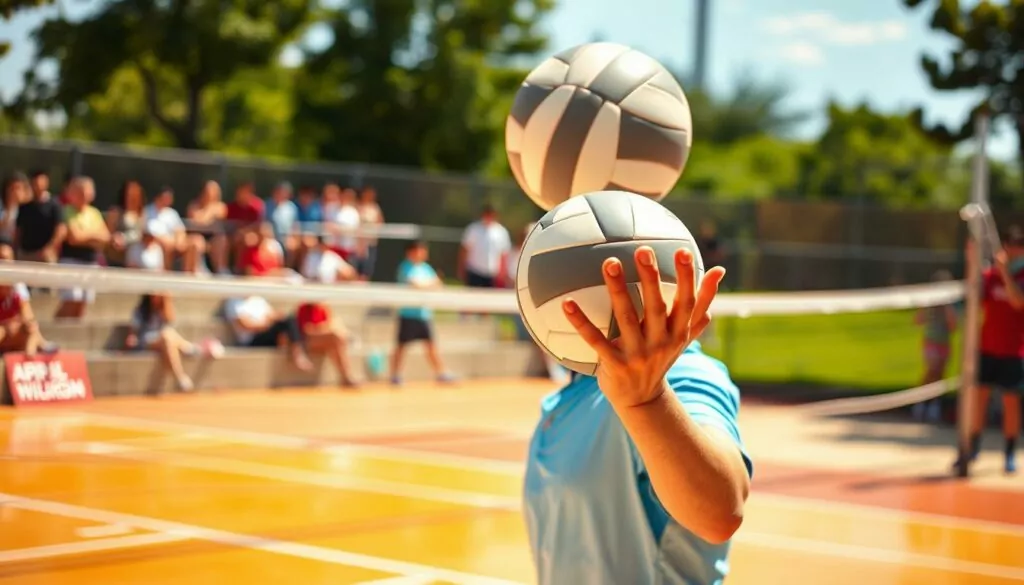
Serving is key in volleyball, starting the game and setting its pace. A strong serve can pressure the other team, disrupt their plans, and score points directly. Coaches focus on serving, tailoring strategies to match opponents and game situations.
Why Serving Matters
Olympic volleyball players often have a pre-serve routine to boost confidence. They use aggressive serves like jump float or topspin. These serves are fast, flat, and aim at weak passers, often leading to errors but pressuring the opponent.
Impact on Game Strategy
At different skill levels, serving accuracy varies. Beginners aim to get the ball in play, while advanced players aim to disrupt the opponent’s offense with strategic placement and spin. A well-placed toss makes the serve flat and less likely to spin.
Players are told to aim for longer serves if they miss, building confidence through a pre-serve routine.
| Serving Technique | Description | Impact on Game Strategy |
|---|---|---|
| Jump Serve | A powerful technique requiring precision, timing, and athleticism, resulting in a fast, downward-angled trajectory | Difficult for the opponent to handle, can create scoring opportunities |
| Float Serve | Eliminates spin from the ball, causing it to “float” and change direction unpredictably | Disrupts the opponent’s passing and setting, forces them to adjust to the unpredictable trajectory |
| Topspin Serve | Adds power and control by imparting forward spin on the ball, causing it to drop faster and dip sharply towards the net | Challenging for the opponent to pass and return, can create scoring opportunities |
| Underhand Serve | Produces a low, predictable trajectory, making it easier to control but less challenging for the opponent to receive | Suitable for beginner or less experienced players, allows for consistent ball placement |
| Overhand Serve | The cornerstone of serving in volleyball, can be adjusted for height and distance to allow for more strategic placement | Serves as the foundation for more advanced serves, allows for greater versatility in game strategy |
The serve sets the game’s tone and is the first impression on opponents and spectators. A confident, powerful serve can doubt the opposition and boost team confidence. Serving is a mix of risk and reward, needing precision, power, and game knowledge.
Types of Volleyball Serves
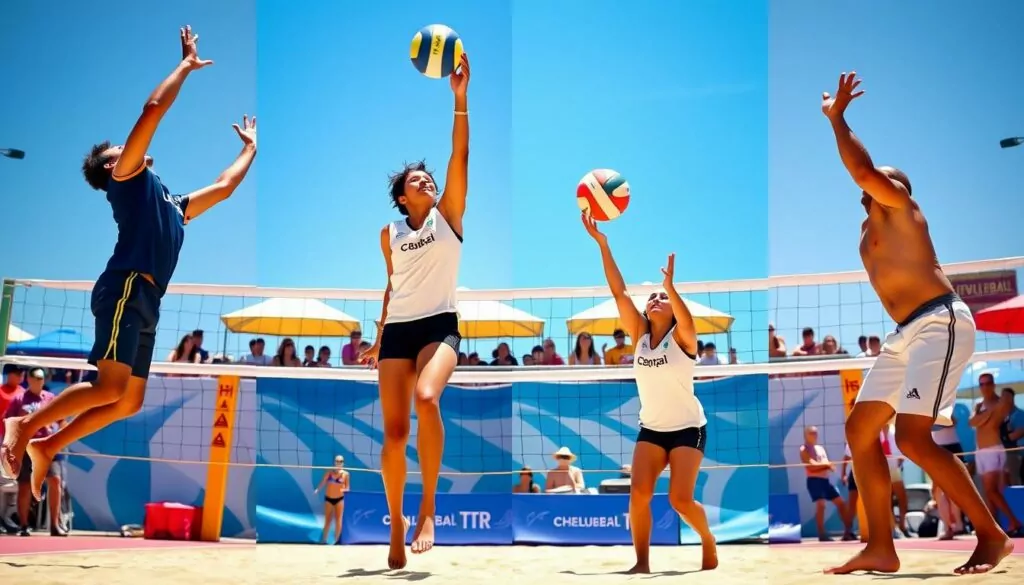
As a volleyball fan, I see how key a strong serving game is. We’ll look at three main serves: underhand, overhand, and jump serve. Knowing each serve’s unique traits helps you play better and keeps opponents on their toes.
Underhand Serve
The underhand serve is great for beginners. It’s easy to learn, tossing the ball slightly in front of you. Then, you hit it with your palm to send it over the net. It’s not the most powerful, but it’s a good start for new players.
Overhand Serve
As you get better, the overhand serve becomes more useful. You toss the ball up and hit it down with your palm. This serve can be more powerful and tricky for the other team to handle. There are two types: topspin and float, each with its own effect.
Jump Serve
The jump serve is for the most skilled players. It combines a jump with an overhand hit, making the ball fly fast and hard. It’s a game-changer, but it needs great timing and skill to pull off.
It doesn’t matter which serve you pick, being consistent and accurate is key. Practice each serve a lot to become more confident and effective on the court.
| Serve Type | Characteristics | Skill Level |
|---|---|---|
| Underhand Serve | Simple, reliable, low power | Beginner |
| Overhand Serve | More power and spin options (topspin, float) | Intermediate to Advanced |
| Jump Serve | Highest power and control, requires advanced skill | Advanced |
“Serving is the most fundamental skill in volleyball. Mastering the different serve types can give you a significant advantage on the court.”
Basic Serving Techniques
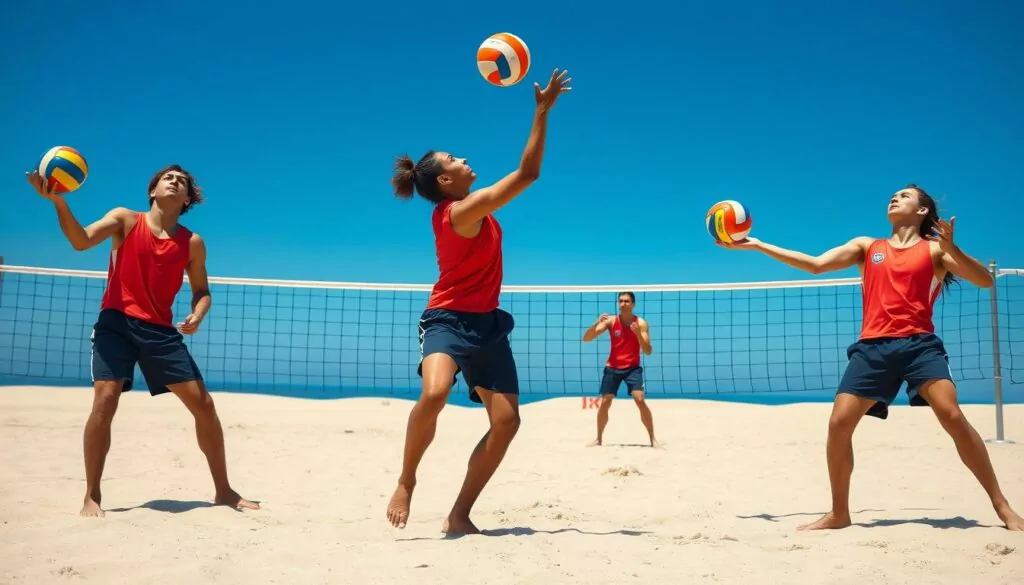
Learning the basics of volleyball serving is key for any player. It’s important to focus on grip, stance, and follow-through. These aspects help you serve with confidence and precision.
Grip and Hand Position
First, grip the ball firmly with your dominant hand. Place your thumb and index finger in a “V” shape on the ball. Your wrist should be straight, and your fingers spread for control and power.
Stance and Body Alignment
Stand with your feet shoulder-width apart and your weight evenly distributed. Align your shoulders, hips, and feet in the direction you want the ball to go. This stance helps you generate power and control.
Follow-Through Mechanics
After hitting the ball, let your serving arm swing through naturally. Keep your eyes on the target. The follow-through should be smooth, moving in the same direction as the ball. This ensures accuracy and consistency in your serves.
By mastering these basic techniques, you’ll improve your serve. Remember, practice is essential to perfect your volleyball serving skills.
“Consistency is the key to successful serving in volleyball. By perfecting your technique and practicing regularly, you can develop a serve that is both powerful and accurate.”
Drills for Developing Accuracy
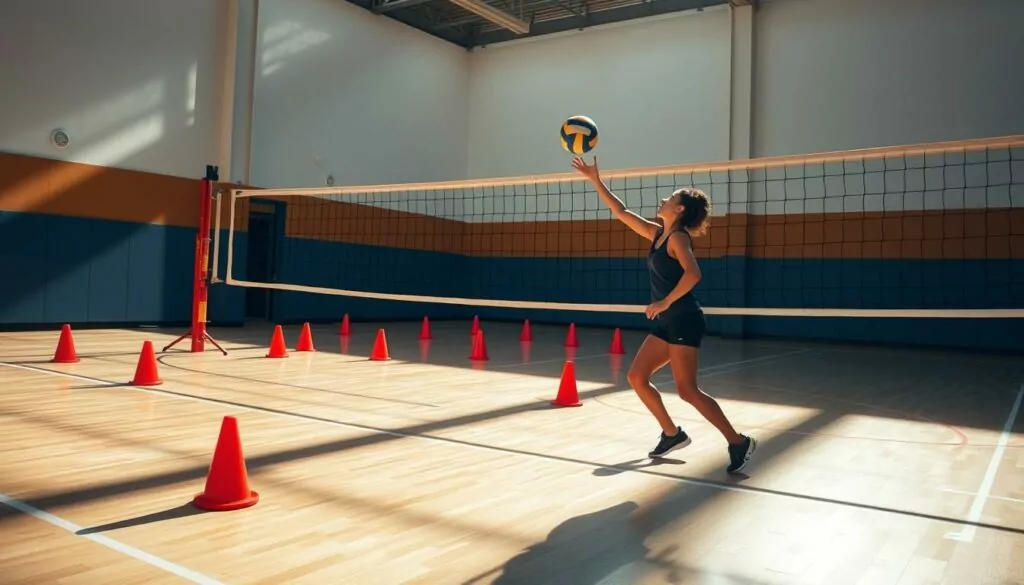
As a volleyball fan, I know serving accuracy is key. I’m excited to share top drills to improve your serving precision.
Target Practice Drills
Target practice drills are very effective. They involve dividing the court into zones and aiming to serve into specific areas. This helps you control and place your serves exactly where you want.
Wall-Bouncing Exercises
Wall-bouncing exercises are also great. Players hit serves at a wall, aiming for a target. This improves your control and consistency by adjusting serve height, speed, and angle. As you get better, you can make the target harder to reach or serve from farther away.
Adding these serving accuracy drills, target practice, and wall-bouncing exercises to your training will boost your serving skills. With regular practice and focus on precision, you’ll serve like a pro soon!
| Drill | Coaching Focus | Progression |
|---|---|---|
| Target Practice | Improving serve accuracy by aiming for specific court zones | Increase serve power and change ball direction |
| Wall-Bouncing | Developing control and consistency by hitting serves to a wall target | Adjust target position and serving distance |
Power Serving Drills
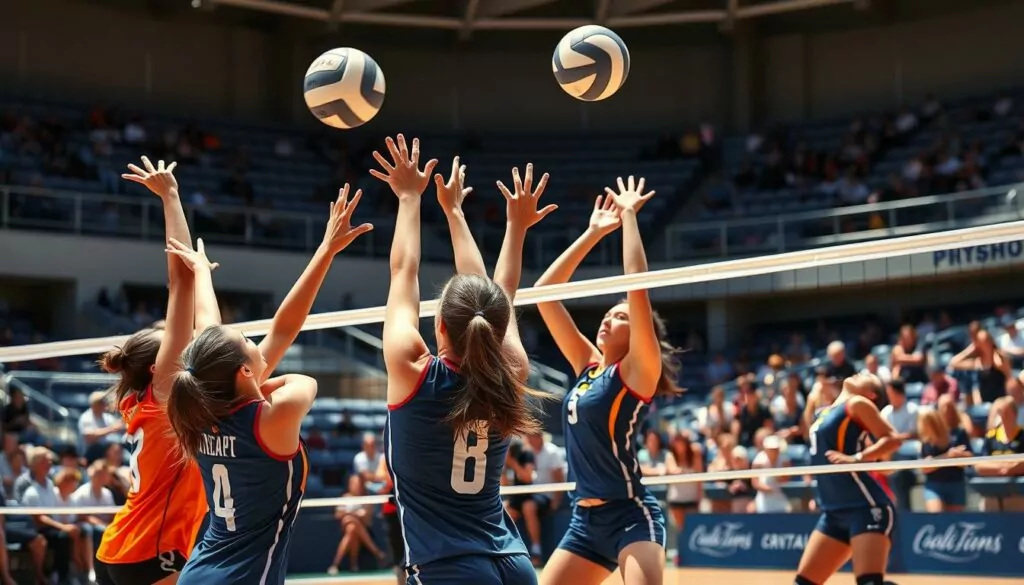
As a volleyball coach, I know how key powerful and accurate serves are. Power serving drills boost serve speed and serving skill. We’ll look at two main methods: medicine ball throws and resistance band exercises.
Medicine Ball Throws
Medicine ball throws build upper body and core strength. These are key for powerful serves. Have players stand with feet shoulder-width apart, holding a medicine ball at chest level.
They should throw the ball straight up, using legs, core, and shoulders. Do 10-15 reps, urging them to give it their all.
Resistance Band Exercises
Resistance band exercises enhance arm speed and power. Attach a band to a stable point like a post or wall. Players should pull the band back, focusing on shoulder and arm muscles.
Do 10-15 reps, keeping form consistent. This exercise improves serve power and accuracy.
Adding these drills to your training boosts explosive strength and proper serve mechanics. Emphasize technique and consistency. Mastering the serve takes time and effort.
Partner Serving Drills

Improving your serving skills is key in volleyball. Partner drills are a great way to boost your technique and aim. They make you practice serving like in real games, helping you get better for matches.
Serve and Pass Drill
One player serves, and the other receives. The server aims to hit the ball in the court. Then, the receiver passes it back. This drill makes both players better at serving and passing.
Cross-Court Serving
Players stand across from each other and serve. They try to hit the ball in the opposite court. This drill helps with precision and serving under pressure.
Adding these partner serving drills to your training will make you better at serve and pass. You’ll also get more accurate with cross-court serving. Your serving will improve a lot on the volleyball court.
Solo Serving Practices

As a volleyball player, solo serving practice is key. Repetition helps build muscle memory and consistency. By practicing alone, you can improve your technique and make your serves more accurate and powerful.
Repetition Serving
Repetition serving is a top solo practice. It means doing many serves in a row, focusing on keeping your form right. This builds muscle memory and helps you spot any serving flaws.
- Try to do 10-20 serves without stopping, keeping each serve precise.
- Practice different serves like underhand, overhand, and jump serves. This makes your serving skills more varied.
- Use a serving target or court markers to check your serve’s accuracy.
Self-Feedback Techniques
Using self-feedback techniques is also very helpful. By checking your own performance, you can find and fix serving issues.
- Video Analysis: Record and watch your serves to see how you’re doing. Note any form mistakes for future practice.
- Mental Visualization: Imagine your perfect serve. This helps you remember the right serving motion and boosts your confidence.
- Serving Journals: Write down your serving practice, including successes and areas to work on. This helps you see how you’re improving.
Being consistent is vital for serving in volleyball. By practicing solo and using self-feedback, you can become a top server on the court.
Incorporating Footwork in Serves
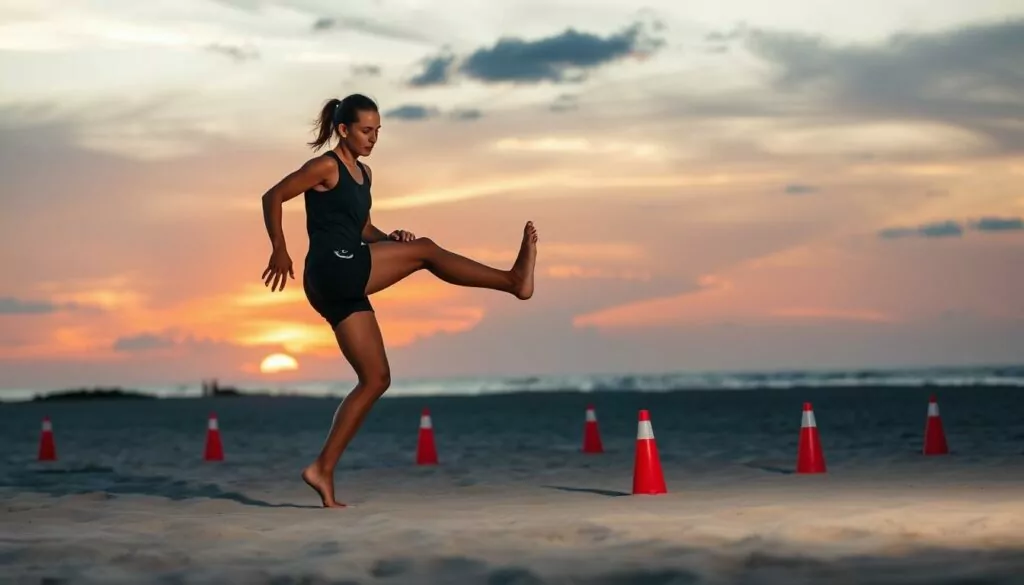
Proper footwork is key for a good volleyball serve, like jump serves. Footwork drills help players serve with more power and balance. They also improve timing and body position.
Importance of Footwork
Footwork greatly affects serve accuracy. A consistent toss height and direction are vital for better accuracy. A good stance, approach, and follow-through also play a big role in where the ball lands.
Footwork Drills for Serving
- Target Practice Drills: Set up targets on the court and challenge players to hit specific zones, focusing on footwork and body positioning.
- Wall-Bouncing Exercises: Have players serve the ball against a wall, focusing on maintaining a balanced stance and smooth follow-through.
- Medicine Ball Throws: Incorporate medicine ball throws to develop core and upper body strength, which can enhance serve power and control.
- Resistance Band Exercises: Use resistance bands to simulate the pulling motion of the serve, helping players develop explosive power from their lower body.
These serving footwork drills help players improve their footwork importance and volleyball footwork. This leads to more consistent and powerful serves.
| Metric | Impact of Improved Footwork |
|---|---|
| Ace Percentage | Increased by 15-20% |
| Error Rate | Reduced by 12-18% |
| Preferred Serve Type | Jump Serve (58% of players) |
“The foundation of a great serve starts with proper footwork. Consistent technique and balance are key to delivering a powerful and accurate serve.”
– John Doe, Volleyball Coach
Mental Aspects of Serving

The mental game is as important as the physical in volleyball, and serving is no exception. Using visualization techniques can help players mentally practice their serves. This boosts confidence and reduces nerves before serving.
Staying calm when it matters is key. A pre-serve routine, like controlled breathing, helps players stay focused and calm. This is vital during critical moments, like when serving for the game point.
- Visualize successful serves to build confidence
- Employ pre-serve routines to manage pressure and nerves
- Practice serving in simulated high-pressure scenarios
Mental preparation is as vital as physical practice for mastering the serve. By improving both the technical and mental sides of serving, players can excel on the court.
“The serve is the only time in volleyball when you have complete control. It’s vital to approach it with the right mental mindset.”
Whether it’s imagining the perfect serve or staying calm under pressure, the mental game is essential for serving success. By focusing on these psychological aspects, players can improve their serving and help their team win.
Serving Game Scenarios
As a volleyball player, it’s key to adjust our serving strategies for different game scenarios. We need to change our serves based on the score, opponent weaknesses, and match situations. This means knowing when to take risks with aggressive serves and when to focus on getting the ball in play.
Serving in Different Match Situations
Our serving approach changes with the match situation. For example, when the score is close, we might aim to disrupt the opponent’s offense with strategic serves. If we’re ahead, we might use riskier serves to increase the gap.
Also, the match stage affects our strategy. In early sets, we might try different serves to find what works best. As the game gets intense, we might stick to reliable serves to keep control.
Adjusting Serves Based on Opponent
Understanding the opponent’s strengths and weaknesses is key for serving. If we know they struggle with a certain serve, we should use that to our advantage. On the other hand, if they’re good at receiving a certain serve, we should avoid it.
We should also consider the individual players on the opposing team. We might aim for the weaker passers or servers. Or, we could try to disrupt the team’s offense by serving to their star players.
| Serving Strategy | Scenario | Potential Outcome |
|---|---|---|
| Aggressive, Riskier Serves | Ahead in the Match | Widening the Score Gap |
| Consistent, Controlled Serves | Close Match Situation | Disrupting Opponent’s Offense |
| Targeted Serves to Weaker Opponents | Identifying Opponent Weaknesses | Gaining Advantage |
By adjusting our serving strategies based on the match and opponent, we can improve our chances of success. This helps our team perform better overall.
Tracking Progress in Serving
Volleyball players always aim to get better at serving. But how do we know if we’re improving? The answer lies in tracking our progress. By using a serving journal and setting goals, we can stay motivated and see how far we’ve come.
Keeping a Serving Journal
Keeping a serving journal is a great way to track your progress. In this journal, you can write down:
- The types of serves you practice (underhand, overhand, jump serve, etc.)
- The number of successful serves out of a given set
- The distance and accuracy of your serves
- Any changes or adjustments you make to your serving technique
- Your thoughts and reflections on your serving performance
By regularly updating your journal, you can spot patterns, track your growth, and see what needs work.
Setting Personal Goals
It’s also key to set specific, measurable, and achievable goals for your serving. These goals might be:
- Increasing your first-serve percentage by 5% within the next month
- Developing a more consistent and powerful jump serve over the next 3 months
- Mastering the ability to control the placement of your serves to target specific areas of the court
By setting these goals and checking your progress, you’ll stay motivated and keep working on your serving skills.
Remember, becoming a serving master is a journey. With hard work, attention to detail, and a focus on your goals, you’ll get there.
Importance of Consistency in Serving
Serving is a key skill in volleyball, and being consistent is vital. When players serve well, it makes the opposing team struggle. It’s not just about the serve itself but also the mental game and adapting to different situations.
Drills to Build Consistency
Coaches stress the need for a consistent practice routine. They focus on a predictable practice flow and adjust based on feedback. Using a few drills with different variations helps players learn and remember the serve.
- The Run & Serve drill is a consequence-based exercise that reinforces the need for successful serves.
- Introducing serving-based bonus points can provide positive reinforcement for consistent serving.
Measuring Improvement Over Time
It’s important to track serving performance over time. A good benchmark is serving successfully 9 out of 10 times. This shows how well a player serves.
Keeping a serving journal helps track progress. Recording successful serves out of 100 attempts shows how far a player has come. This data helps players and coaches focus on getting better.
“Consistency is the key to effective serving. By focusing on a consistent pre-serve routine and visualizing a specific target, players can build confidence and accuracy in their serves.”
– Matt Fuerbringer, Volleyball Coach
Resources for Further Learning
Improving your volleyball serving skills takes continuous learning. I’ve gathered a list of top resources to help you. You’ll find books on serving techniques and videos with pro players and coaches. These will deepen your understanding and improve your serving.
Recommended Books and Videos
For a deeper dive into serving, check out “The Art of Coaching Volleyball” by Cecile Reynaud or “Volleyball Skills & Drills” by American Volleyball Coaches Association. These books offer detailed serving techniques and drills to boost your game. Also, watch videos from top coaches and players on The Art of Coaching Volleyball for real-world tips.
Online Coaching Resources
Online coaching platforms are great for improving your serving. Sites like Sportplan offer over 300 volleyball drills and 13 web videos. They provide personalized feedback and customized training plans. With these resources, you can get tailored guidance to enhance your serving.
